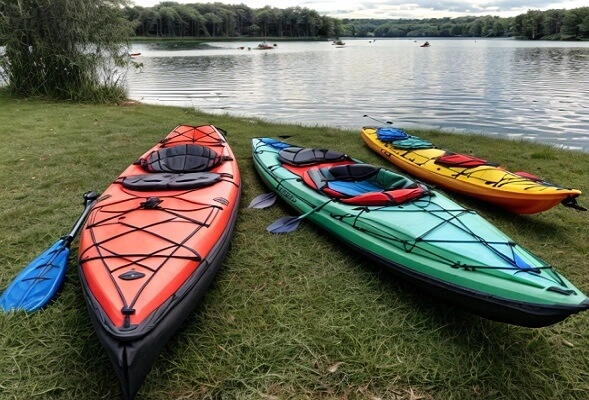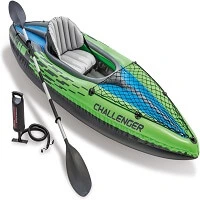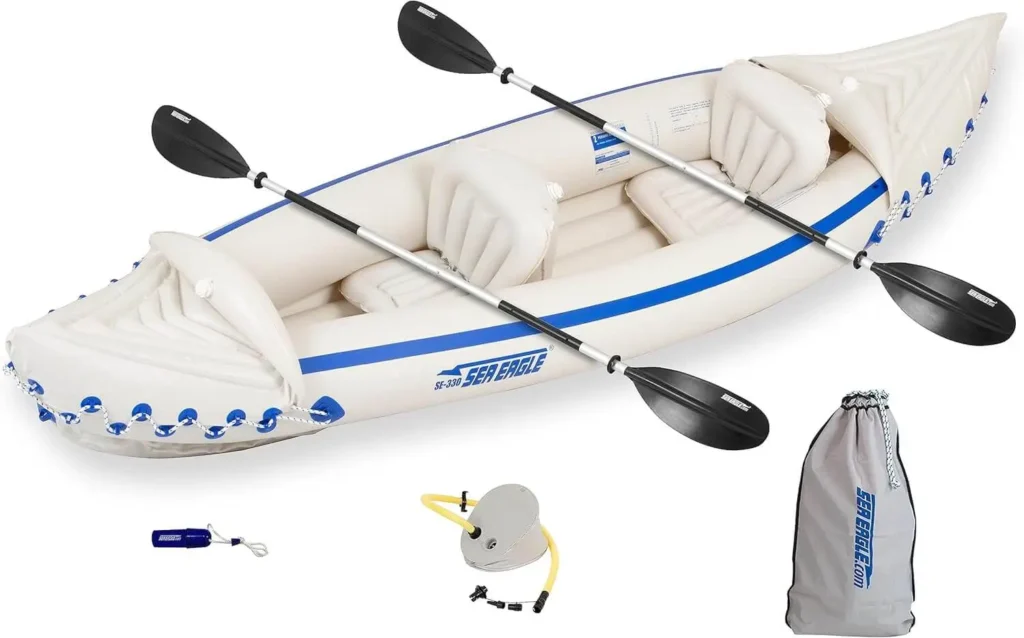The popularity of inflatable kayaks, often known as air kayaks or blow-up kayaks, has increased. Prominent producers have consistently improved the materials and construction, taking them beyond leisure boats. These inflatable kayaks are now acknowledged as a competitive substitute for conventional solid kayaks. This in-depth guide dives into the world of air kayaks, examining how they differ from their folding and solid counterparts, weighing their advantages and disadvantages, and outlining their various uses. Whether you consider yourself a novice, an occasional paddler, or an experienced expert, our guide ends with a selection of the best inflatable kayaks suited to your requirements.

Table of Contents
What is an inflatable kayak?
A kayak is a stylishly shaped paddle boat driven by two paddles. Conventional kayaks have a deck covering that protects the paddler from waves and spray. Sitting in the direction of travel is the paddler. Kayaks came from the Eskimos of Greenland, where they were originally used for hunting due to their great speed and agility. Kayaks are now a necessary component of touring and water sports.
Their adaptability makes them perfect for long-distance kayaking and high-speed paddling. Kayaks are popular even among novices, providing a pleasant and comfortable experience on the water.
Air kayaks, another name for inflatable kayaks, are usually made of rubberized PVC or woven fabrics coated in PVC. The boat chambers must be filled with air using an air pump as part of the inflation procedure. The amount of air pumped into the chambers varies depending on the kayak’s material, which affects the operating pressure. Improved driving qualities and rigidity are the outcomes of increased pressure. Kayaks with higher operating pressure levels are typically more expensive, which is indicative of their superior features and capabilities.
When inflatable kayaks first appeared, many were skeptical since they were more prone to damage and had different handling qualities than hardshell kayaks. Nonetheless, notable advancements have made them well-liked options for tourism and whitewater rafting. A fair trade-off has been made, guaranteeing a combination of durability, small size, light weight, and good driving qualities. Although inflatable kayaks are becoming more and more popular, hard-shell kayaks are still the preferred choice for competitive kayaking.
Manufacturers of inflatable kayaks
Many well-known brands, including Advanced Elements, Sea Eagle, Aquaglide, Aqua Marina, BIC, Blueborn, Bestways, Gumotex (known as Innova in the USA), Grabner, Sevylor, Itiwit, Intex, and many more, are among the numerous inflatable kayak manufacturers that have entered the market in recent years. Leading the pack is Advanced Elements, which is becoming more and more well-known throughout the world as the leading brand of premium inflatable kayaks in the USA. Targeting a wide spectrum of paddlers, from novices to pros, Advanced Elements offers a selection of kayaks with outstanding driving qualities.
Regarding inflatable kayaks, Intex is a well-known competitor that offers some of the most reasonably priced products available. For example, the Intex Challenger K1, a one-person inflatable kayak, costs less than $100. Intex mostly caters to novice paddlers looking for a calm and relaxing experience on a lake or beach when the weather is nice.
Comparable products are available from Sevylor and Itiwit, which, unlike Intex kayaks, have a textile covering for increased durability and a little higher air pressure. Notably, Itiwit has enhanced the cover of its new starter models with a boat skin made from PVC-coated polyester fabric, illustrated by the Itiwit x100, and has extended its line to include inflatable touring kayaks, such as the Itiwit x500.

How much does an inflatable kayak cost?
The characteristics of an excellent inflatable kayak depend on the user’s needs and the intended use. Most people agree that inflatable kayaks that cost more are of greater quality, which translates into better performance and a longer lifespan when used on the water. According to our evaluation, a good inflatable kayak usually costs between $500 and $1000. But it’s important to remember that high-end inflatable kayaks that cost more than $1000 are available, providing enthusiasts looking for the best in terms of longevity and performance with cutting-edge technology and quality construction.
Undoubtedly, not everyone needs or has the means to purchase a $1000 inflatable kayak. We want to offer attractive inflatable kayaks in three different categories, many of which we’ve ridden ourselves, to suit a range of tastes and price points. This method guarantees that there is an inflatable kayak designed to fit your needs, regardless of whether you are an experienced paddler looking for specialized features or an entry-level enthusiast. Let’s examine the choices that fit different needs and budgetary constraints by delving into these categories.
Inflatable kayaks for nice weather and recreational paddlers
These inflatable kayaks cater primarily to occasional paddlers and individuals looking to explore the joys of paddling for the first time.
These inflatable kayaks are the most reasonably priced in our category. These kayaks are less expensive than $100, depending on the deal, and have a thinner boat skin made of PVC film and less air pressure than their competitors. These kayaks are perfect for meandering rivers, small, peaceful lakes, and pleasant beachside paddling in calm seas when the weather is right. They generally include paddles, fins, and pumps as standard equipment. Notably, items in this category include the inflatable kayaks made by Sea Eagle or Intex.
It’s crucial to remember, nevertheless, that these kayaks are not intended for outstanding performance or fine craftsmanship. As an alternative, they make good boats for quick paddles and leisurely times on the water.
INTEX CHALLENGER K1

INTEX EXPLORER K2

Sea Eagle 330

In this price range of $200 to $500, you may get inflatable kayaks designed for sporadic use and shorter trips of two to three hours on calm waters. Prominently marketed under the names Itiwit and Sevylor, these kayaks have a higher operating pressure and PVC tubes that are either made of a more durable material or protected by a separate textile cover. These inflatable kayaks are more durable and easier to paddle than the more affordable models, so they’re a good option for anybody looking to strike a compromise between price and performance.
INTEX EXCURSION PRO 2

ITIWIT X100+

ITIWIT X100 3 SEATER

Materials Used
One of the most important factors affecting an inflatable kayak’s longevity and possible uses is the type of material chosen for the boat skin. Boat skins are made of a variety of materials, many of which are combined by the manufacturer to meet certain performance goals.
Although the material’s thickness and durability are frequently highlighted in product descriptions, it’s vital to remember that inflatable kayaks with durable, thick boat skins are frequently more expensive. Cheap inflatable kayaks are usually not as durable as those made with coated fabric, which is what companies like Gumotex (Innova) use. Inexpensive inflatable kayaks might only have a very thin PVC skin, which is stronger than an air mattress but still not thick enough for regular paddling and possible ground contact.
Some manufacturers use a design in which the boat skin is separate from the air chamber itself. In order to protect the air chamber from potential harm, it is covered in a kind of nylon or polyester material in this structure. Certain models from Sevylor, Itiwit, and Advanced Elements have this functionality. The cover is composed of a more durable material than the PVC used for the air chambers. Nevertheless, there are disadvantages to this design, including longer drying times following paddling and a chance of mold development. PVC and rubberized fabric fabrics, on the other hand, are easily wiped dry after paddling.
Repairing air kayaks covered with polyester or nylon presents a unique set of difficulties. Tears in these textiles might be difficult to mend. Rubberized fabric materials, on the other hand, are easy to fix if something goes wrong; it’s like repairing a bicycle tube.
Air Pressure and Use of Drop-Stitch
An inflatable kayak’s performance and stability are greatly influenced by the air pressure inside of it. We personally think that 2.9 PSI, or 0.2 bar, of air pressure is just fine. Higher air pressure improves driving qualities and stiffness, but because it requires more sophisticated hose manufacturing, it also means a higher purchasing price.
Drop-stitch material has been used in some inflatable kayak models recently for the sidewalls and bottom. While drop-stitch technique is widely used in inflatable kayaks, inflatable paddleboards have been the main application for this technology. High-pressure air chambers can be created using drop-stitch technique, allowing for inflation to well above 0.3 bar (4.3 PSI). This method gives the canoe exceptional rigidity by weaving textile threads through the inner walls of the chamber. It’s important to remember, though, that drop-stitch canoes are still wind-sensitive.
These developments, which include features like changeable air pressure and drop-stitch materials to improve overall performance, demonstrate the ongoing evolution of inflatable kayak design.
Inflatable Kayak Safety
Inflatable kayak safety is paramount for an enjoyable and risk-free paddling experience. Whether you’re a beginner or an experienced paddler, adhering to safety guidelines ensures a smooth and secure journey on the water.
- Life Jackets: Always wear a suitable personal flotation device (PFD) or life jacket. Ensure it is properly fitted and fastened before entering the inflatable kayak. PFDs are crucial for buoyancy and personal safety.
- Check Equipment: Before each use, inspect your inflatable kayak for any visible damage, leaks, or punctures. Ensure that all valves, seams, and chambers are in good condition. Pay special attention to the paddles, seats, and other accessories.
- Inflation and Air Pressure: Inflate the kayak according to the manufacturer’s recommendations and guidelines. Overinflation or underinflation can affect stability and performance. Check the air pressure regularly during your trip, especially if there are significant temperature changes.
- Weather Awareness: Stay informed about the weather conditions before heading out. Avoid paddling in adverse weather, strong winds, or storms. Sudden weather changes can pose risks, so plan your outings accordingly.
- Skill Level: Be aware of your paddling skill level and choose water bodies that match your expertise. Beginners should start on calm, flatwater areas before progressing to more challenging conditions.
- Emergency Gear: Carry essential safety and emergency equipment, such as a whistle, signaling devices, and a first aid kit. Be familiar with how to use these items in case of unexpected situations.
- Navigation and Route Planning: Plan your route in advance, and be aware of potential hazards like rocks, currents, or obstacles. Have a map or GPS device to assist with navigation. Inform someone about your paddling plans and expected return time.
- Group Paddling: Whenever possible, paddle with a group. Group paddling enhances safety as there is mutual assistance in case of emergencies. Ensure effective communication within the group.
- Respect Regulations: Adhere to local regulations and guidelines for water activities. Be aware of any specific rules related to the water body you are paddling on.
- Training and Courses: Consider taking paddling courses or training sessions, especially if you’re new to inflatable kayaking. Learn basic paddling techniques, rescue procedures, and safety protocols.
Pros and Cons
Pros
- Portability: Inflatable kayaks are highly portable and convenient for travel. They can be deflated, folded, and easily transported, making them suitable for various locations.
- Storage Space: These kayaks require minimal storage space, making them ideal for those with limited storage options. They can be stored in small spaces when not in use.
- Ease of Transportation: Inflatable kayaks are lightweight, making them easy to carry to and from the water. This is beneficial for solo paddlers or individuals with limited physical strength.
- Versatility: They are versatile and suitable for various water conditions, including calm lakes, rivers, and mild whitewater. This adaptability makes them appealing to a wide range of paddlers.
- Durability: Modern inflatable kayaks are constructed from durable materials that resist punctures and abrasions. High-quality models can withstand rough conditions and provide long-lasting performance.
- Affordability: Inflatable kayaks are often more affordable than their hard-shell counterparts, making them accessible to beginners or casual paddlers.
- Quick Setup: Inflatable kayaks can be inflated and ready for paddling within a relatively short time. This quick setup is advantageous for spontaneous outings or when time is limited.
- Comfort: Many inflatable kayaks are designed with comfortable seating and ergonomic features, allowing paddlers to enjoy extended trips without discomfort.
Cons
- Performance: Inflatable kayaks may not match the performance capabilities of hard-shell kayaks. They might be slower and less maneuverable, especially in advanced paddling scenarios.
- Tracking: Maintaining a straight course, known as tracking, can be a challenge for some inflatable kayaks. This can affect the overall paddling experience, particularly in open water with currents or wind.
- Puncture Risk: While durable, inflatable kayaks are still susceptible to punctures from sharp objects. Paddlers need to be cautious of potential hazards in the water.
- Setup Time: Despite being quicker to set up than rigid kayaks, inflatables still require inflation and assembly. Some paddlers might find this setup process less convenient than simply placing a hard-shell kayak in the water.
- Weight Limitations: Inflatable kayaks may have weight limitations compared to rigid kayaks. This can impact the number of passengers or the amount of gear a kayak can carry.
- Longevity: Although durable, inflatable kayaks might have a shorter lifespan than hard-shell kayaks. Factors such as exposure to sunlight and frequent use can affect their overall longevity.
- Maintenance: Proper maintenance is essential to ensure the kayak’s longevity. This includes regular cleaning, checking for leaks, and storage considerations. Neglecting maintenance can lead to performance issues.
Conclusion
In conclusion, choosing an inflatable kayak involves weighing the advantages and disadvantages to align with individual preferences and specific use cases. The convenience of portability, easy storage, and affordability make inflatable kayaks an attractive option, particularly for beginners or casual paddlers. Their versatility allows enjoyment in various water conditions, albeit with some compromises in performance.
While durable, these kayaks demand careful consideration of potential puncture risks. The quick setup and comfortable features enhance the overall experience, but users should be mindful of their limitations in tracking and weight capacity. With proper care and adherence to maintenance routines, inflatable kayaks offer a practical and accessible entry point to the world of paddling, providing an enjoyable water experience for a broad range of enthusiasts.